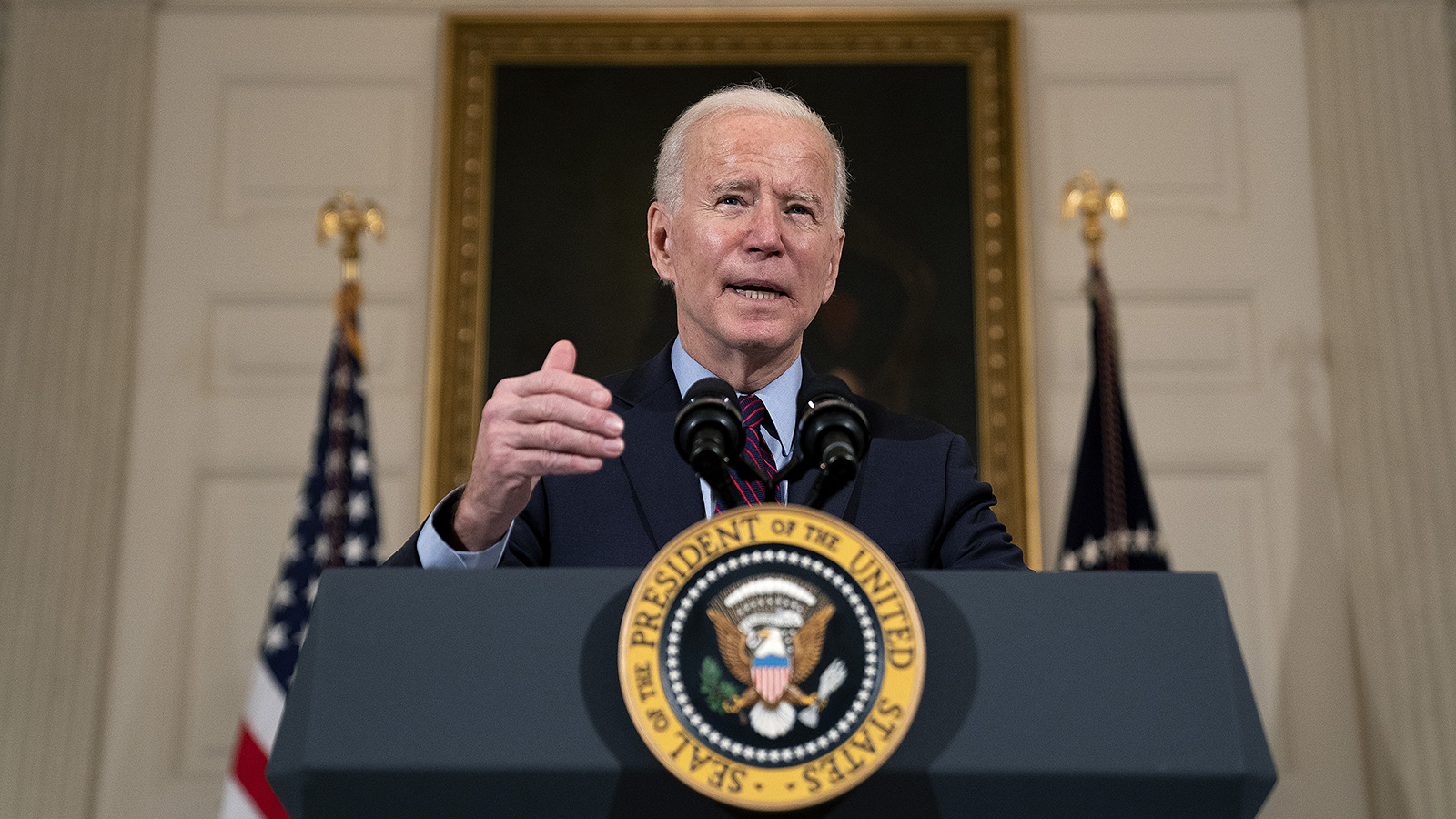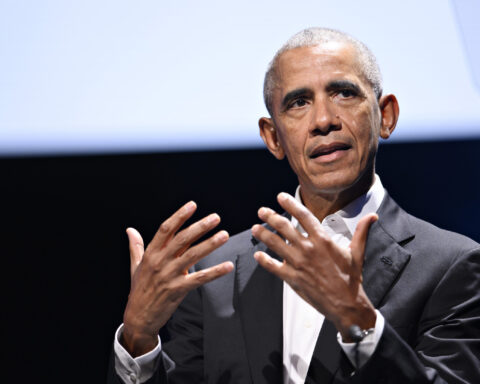President Joe Biden had been in office less than a week when a federal judge issued a nationwide injunction blocking one of his first immigration-related actions.
The order was a victory for Texas Attorney General Ken Paxton, who crowed “WE WON” on Twitter. In fact, Paxton, a controversial conservative Republican, had successfully gambled that his challenge would land before a judge appointed by President Donald Trump. And indeed Judge Drew B. Tipton — appointed by Trump in 2020 — delivered.
The order is a potent reminder of the power of the judiciary to cripple a president’s forward momentum on an issue. It also highlighted the fact that elections matter — giving an incoming president the chance to create a lasting legacy. Trump, for example, was able to appoint 234 judges, including three Supreme Court justices.
RELATED: Trump transformed the Supreme Court that mostly helped advance his agenda
Now it’s Biden’s turn, and so far his administration is signaling that judicial nominations will be a major priority and that Democrats may even tear pages from Trump’s playbook on the issue.
There are 60 current eligible vacancies and 20 vacancies that will occur down the road as judges have formally announced their intentions to retire, take senior status or resign, according to the Administrative Office of the US Courts.
One other factor could be a game changer for Biden: the lingering possibility that 82-year-old Justice Stephen Breyer might choose to step aside this term or next and give Biden his first chance to name a Supreme Court justice.
Biden has vowed to appoint the first Black woman to the Supreme Court, and even before his inauguration his transition team sent a letter to Democratic senators seeking recommendations for district court vacancies that might arise.
There is also an effort afoot to speed up the confirmation process by no longer allowing the American Bar Association to vet judicial candidates before they are nominated.
Some progressives, however, have legitimate concerns regarding whether the White House and the Senate will maintain the discipline and stamina necessary over the coming weeks and months to keep judges a priority as attention shifts to other areas.
They still remember that President Barack Obama came up short when faced with a similar opportunity early in his presidency, and they believe he squandered an opportunity to focus on the courts.
Chris Kang, chief counsel for the progressive group Demand Justice, believes things will be different now.
“President Biden’s approach to judicial nominations is going to put the nail in the coffin of the conventional wisdom that Democrats don’t care enough about the court,” he said in an interview.
Pending vacancies
As things stand, since Biden’s inauguration, judges sitting on powerful courts have already announced plans to go into senior status, giving the new President the chance to replace them with younger nominees.
Since Biden’s inauguration there have been five announced vacancies on the appeals courts as well as a handful on district courts, and more are expected
Judge Robert A. Katzmann, for example, who penned an opinion that would have allowed Trump’s tax records to go to a New York prosecutor, has announced plans to take senior status on the 2nd US Circuit Court of Appeals.
Judge Emmet G. Sullivan, who sits the US District Court in Washington and most recently oversaw the case of former national security adviser Michael Flynn, will also take senior status.
Another notable vacancy will come up once Judge Merrick Garland of the US Court of Appeals for the District of Columbia Circuit is confirmed as Biden’s attorney general. Democrats haven’t forgotten that Garland, nominated by Obama early in 2016 to replace the late Justice Antonin Scalia, was denied a hearing by Senate Republicans, who simply sat on the nomination until the presidential election was over.
The DC Circuit is considered a breeding ground for Supreme Court nominees and served as a steppingstone for Chief Justice John Roberts, as well as Justices Clarence Thomas, Ruth Bader Ginsburg, Scalia and Brett Kavanaugh.
High on the list of potential contenders is Judge Ketanji Brown Jackson, who sits on the US District Court for the District of Columbia. She is a former Breyer clerk who also served as a public defender. California Supreme Court Justice Leondra Kruger is a potential nominee for Breyer’s seat if he were to step down.
In addition, in the coming weeks, Biden is set to reveal the membership for a bipartisan commission that will take a look at revisions to the Supreme Court, including the potential of term limits and adding more seats to the bench.
How Trump and Senate Republicans transformed the courts
Under Trump, a careful troika composed of White House Counsel Don McGahn, Senate Majority Leader Mitch McConnell and Senate Judiciary Chairman Chuck Grassley worked immediately and almost seamlessly to change the face of the courts.
Democrats were livid and accused the Republicans at times of ignoring the rules in order to bulldoze the process, but with Republicans in the Senate majority all four years of the Trump presidency, the Democrats were unable to stop all but a handful of nominations.
The Republicans ran a closely held vetting operation, eased long-standing institutional norms and, perhaps most importantly, maintained forward momentum, avoiding distraction, as other issues blew up around the presidency.
The process — no easy feat straddling three branches — required discipline and outside backing. Under Trump, the conservative Federalist Society and later a group called The Article III Project were supportive of Trump’s nominees.
“President Trump’s biggest and most consequential accomplishment was his transformation of the federal judiciary, including his solidification of a conservative majority on the Supreme Court and his appointment of a near-record 54 circuit judges to the critically important federal courts of appeals,” said Mike Davis, president of the Article III Project. “These lifetime appointments will provide an important constitutional check on government overreach by the Biden administration.”
In the early Obama years, outside groups often disagreed on potential nominees and the political branches lacked a laser-like focus necessary to accompany a nominee to confirmation.
During the lead-up to the 2016 election, Trump made the Supreme Court and lower courts a campaign issue. Democratic presidential candidate Hillary Clinton rarely brought it up and some liberals squabbled over whether Garland should remain the Democratic pick.
After Trump won, Democrats found themselves helpless as they fought the onslaught of nomination hearings. They were largely sidelined as Justice Neil Gorsuch got the seat once offered to Garland, Kavanaugh won confirmation after perhaps the most ferocious nomination fight in history and conservatives rushed to fill the seat of the liberal icon Ruth Bader Ginsburg with the conservative Justice Amy Coney Barrett. Ginsburg died some four months short of Biden’s inauguration.
The Supreme Court now has a solid 6-3 conservative majority that could last for decades as issues such as abortion, immigration, affirmative action, religious liberty, voting rights and the Second Amendment reach the high court.
A final wake-up call for progressives came at the end of Barrett’s confirmation hearing in October, when Democrats, still furious that Republicans had rushed deadlines in the run-up to the election, witnessed Judiciary Committee ranking member Dianne Feinstein, a California Democrat, hug Chairman Lindsey Graham, a South Carolina Republican, and praise him for his efforts during the hearings.
Then-Senate Minority Leader Chuck Schumer, a New York Democrat, said he had had a “long and serious” talk with Feinstein. Progressives felt betrayed, and it wasn’t long after that Feinstein announced she would step down as top Democrat on the committee.
The Democratic team
Now that Biden is in office, there’s a new troika in town. White House Counsel Dana Remus, Schumer — now the majority leader — and Judiciary Chairman Dick Durbin, an Illinois Democrat, are in place.
Brian Fallon, who runs Demand Justice, launched in 2018, is determined to keep the pressure on from outside of government. His group wants Biden’s team to move away from recent models and nominate a diverse group of individuals including public defenders, civil rights lawyers and legal aid attorneys.
On Friday, Fallon tweeted a stern reminder about the lessons learned from 2009 just after Obama took over. “Don’t listen to Rahm on how much to prioritize judges,” he wrote. It was a not-so-subtle reminder that Rahm Emanuel, Obama’s chief of staff, hadn’t seen the judiciary as a priority.
“This is clearly a new day. We are witnessing a revolution in how Democrats are considering and prioritizing judicial nominees, led by President Biden and embodied by chief of staff Ron Klain,” Kang said.
“They are upending the model of lawyers that Democratic presidents will consider for the judiciary. Prosecutors and corporate lawyers are out; civil rights lawyers, public defenders and labor lawyers are in,” he said.
According to a Democratic aide on Capitol Hill, Durbin will follow the same rules that the Republicans did when the committee was led by Grassley and Graham. They expect to hold hearings at a regular clip and to put forward multiple nominees on any given hearing panel. There will be an emphasis on diversity but also, following Trump, they will look for young nominees who could serve for decades.
Although some questioned whether Congress will prioritize Justice Department nominees over judges, the aide dismissed the concern.
“There is time and there is precedent for moving DOJ nominees alongside of judicial nominees,” the aide said.
“I have every reason to believe that the nominees you will see from this White House will be eminently qualified, which was not always true for nominees you saw put forward by Trump,” the person added.
Momentum will also come from other quarters of the White House, starting most obviously with a President and vice president who both spent time serving on the Judiciary Committee, with Biden as its former chairman.
Klain is a veteran of countless confirmation hearings and a former clerk of Justice Byron White. Paige Herwig, a former top aide to former Attorney General Loretta Lynch as well as a veteran of the Senate Judiciary Committee and Demand Justice, will serve as the nominations counsel and will receive help from Tona Boyd, Sen. Cory Booker’s former chief counsel.
As Biden concentrates on nominations, he will find that his policies and initiatives, like the immigration action temporarily struck by Judge Tipton, will land in the courts.
And while Trump’s nominees did not always vote in his favor, a fact that was made clear as he fought to overturn the election, by and large his nominees will share a conservative legal outlook.
Chief Justice John Roberts may have famously tried to distance the judiciary from Trump’s attacks when he reprimanded the then-President in 2018 by saying that “we do not have Obama judges or Trump judges.”
But the reality is there are Obama, Trump and Biden nominees.
And now, with a new cascade of judicial retirements and an expected avalanche of new executive orders, the judges will make a difference.







